Strategic Marketing Plan: A Detailed Report on Nestle's Essentials
VerifiedAdded on 2023/06/18
|13
|2963
|476
Report
AI Summary
This report provides a detailed analysis of Nestle's marketing essentials, exploring the company's marketing strategies, tactics, and planning processes. It examines the roles and responsibilities of marketing within Nestle and its interrelation with other departments. The report delves into the different ways Nestle utilizes the elements of the marketing mix (7Ps) to achieve its overall business objectives, including product promotion through various channels such as social media and paid advertising. It also evaluates Nestle's marketing plan, highlighting its segmentation, targeting, and positioning strategies, as well as its competitive landscape and supplier relationships. Furthermore, the report discusses Nestle's strategic marketing plan, focusing on the 7Ps (Product, Price, Place, Promotion, People, Process, and Physical Evidence) and how they contribute to the company's competitive advantage and market success. The analysis includes an overview of Nestle's product line, pricing strategies, distribution channels, and promotional activities, providing a comprehensive understanding of Nestle's marketing approach. Desklib offers a variety of similar solved assignments for students.

Marketing essentials
Secure Best Marks with AI Grader
Need help grading? Try our AI Grader for instant feedback on your assignments.
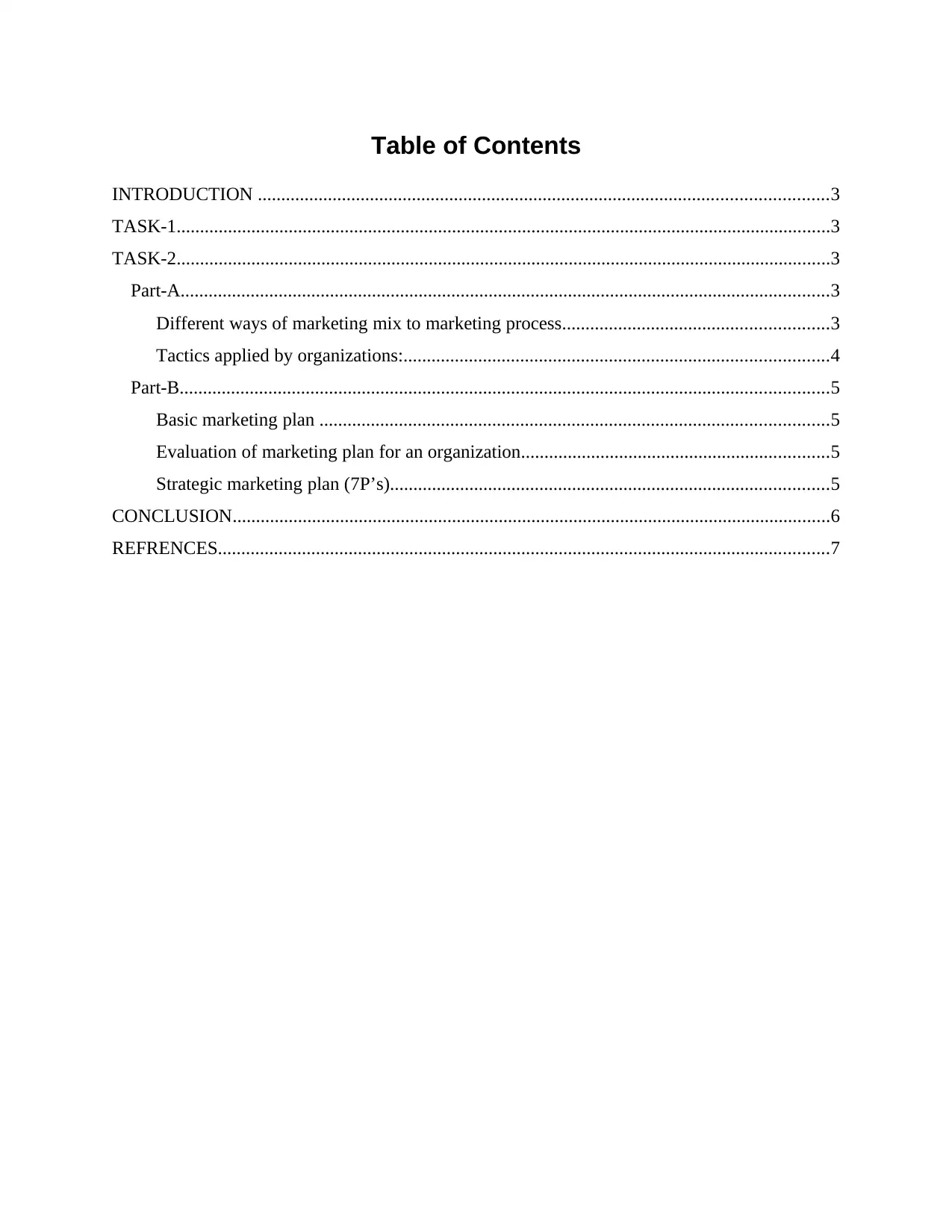
Table of Contents
INTRODUCTION ..........................................................................................................................3
TASK-1............................................................................................................................................3
TASK-2............................................................................................................................................3
Part-A...........................................................................................................................................3
Different ways of marketing mix to marketing process.........................................................3
Tactics applied by organizations:...........................................................................................4
Part-B...........................................................................................................................................5
Basic marketing plan .............................................................................................................5
Evaluation of marketing plan for an organization..................................................................5
Strategic marketing plan (7P’s)..............................................................................................5
CONCLUSION................................................................................................................................6
REFRENCES...................................................................................................................................7
INTRODUCTION ..........................................................................................................................3
TASK-1............................................................................................................................................3
TASK-2............................................................................................................................................3
Part-A...........................................................................................................................................3
Different ways of marketing mix to marketing process.........................................................3
Tactics applied by organizations:...........................................................................................4
Part-B...........................................................................................................................................5
Basic marketing plan .............................................................................................................5
Evaluation of marketing plan for an organization..................................................................5
Strategic marketing plan (7P’s)..............................................................................................5
CONCLUSION................................................................................................................................6
REFRENCES...................................................................................................................................7
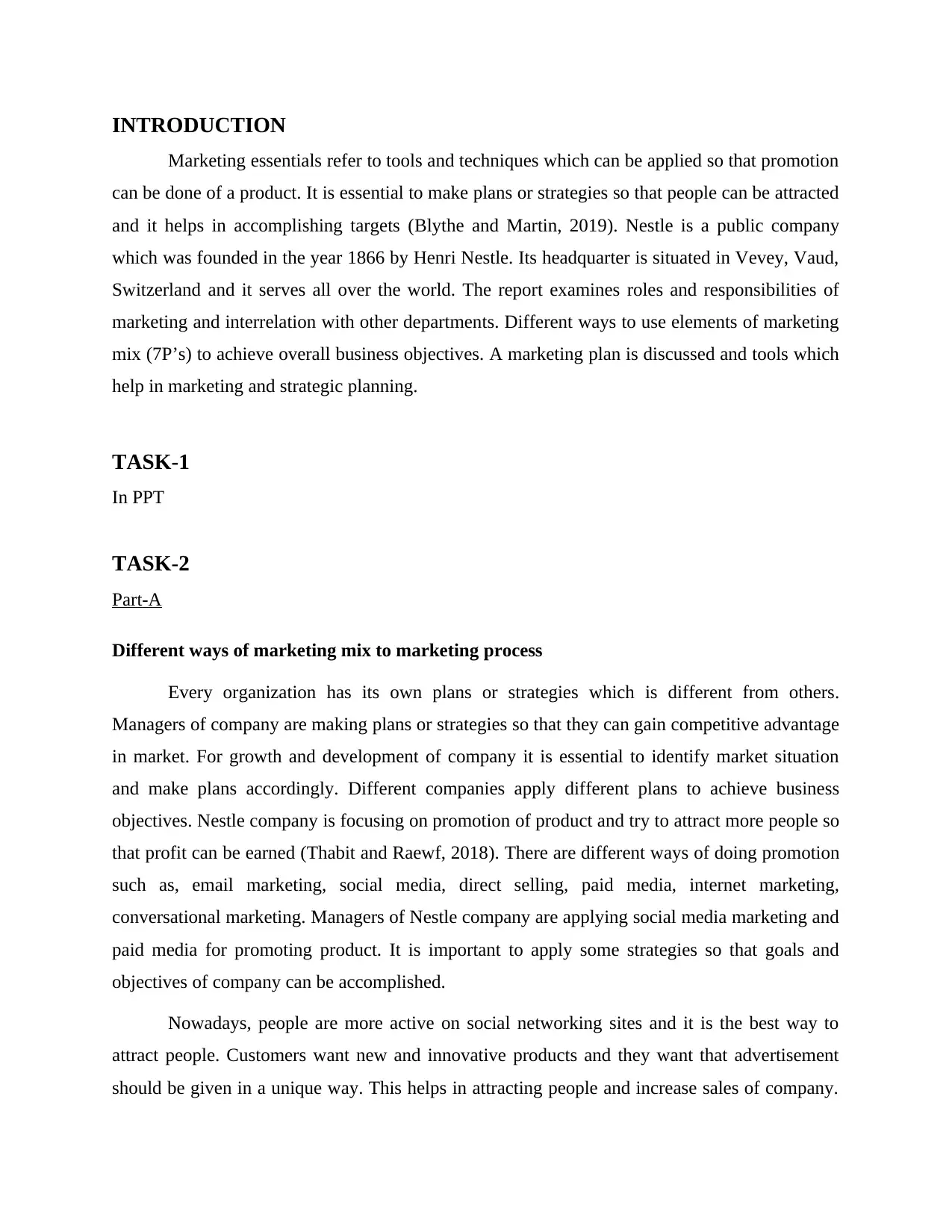
INTRODUCTION
Marketing essentials refer to tools and techniques which can be applied so that promotion
can be done of a product. It is essential to make plans or strategies so that people can be attracted
and it helps in accomplishing targets (Blythe and Martin, 2019). Nestle is a public company
which was founded in the year 1866 by Henri Nestle. Its headquarter is situated in Vevey, Vaud,
Switzerland and it serves all over the world. The report examines roles and responsibilities of
marketing and interrelation with other departments. Different ways to use elements of marketing
mix (7P’s) to achieve overall business objectives. A marketing plan is discussed and tools which
help in marketing and strategic planning.
TASK-1
In PPT
TASK-2
Part-A
Different ways of marketing mix to marketing process
Every organization has its own plans or strategies which is different from others.
Managers of company are making plans or strategies so that they can gain competitive advantage
in market. For growth and development of company it is essential to identify market situation
and make plans accordingly. Different companies apply different plans to achieve business
objectives. Nestle company is focusing on promotion of product and try to attract more people so
that profit can be earned (Thabit and Raewf, 2018). There are different ways of doing promotion
such as, email marketing, social media, direct selling, paid media, internet marketing,
conversational marketing. Managers of Nestle company are applying social media marketing and
paid media for promoting product. It is important to apply some strategies so that goals and
objectives of company can be accomplished.
Nowadays, people are more active on social networking sites and it is the best way to
attract people. Customers want new and innovative products and they want that advertisement
should be given in a unique way. This helps in attracting people and increase sales of company.
Marketing essentials refer to tools and techniques which can be applied so that promotion
can be done of a product. It is essential to make plans or strategies so that people can be attracted
and it helps in accomplishing targets (Blythe and Martin, 2019). Nestle is a public company
which was founded in the year 1866 by Henri Nestle. Its headquarter is situated in Vevey, Vaud,
Switzerland and it serves all over the world. The report examines roles and responsibilities of
marketing and interrelation with other departments. Different ways to use elements of marketing
mix (7P’s) to achieve overall business objectives. A marketing plan is discussed and tools which
help in marketing and strategic planning.
TASK-1
In PPT
TASK-2
Part-A
Different ways of marketing mix to marketing process
Every organization has its own plans or strategies which is different from others.
Managers of company are making plans or strategies so that they can gain competitive advantage
in market. For growth and development of company it is essential to identify market situation
and make plans accordingly. Different companies apply different plans to achieve business
objectives. Nestle company is focusing on promotion of product and try to attract more people so
that profit can be earned (Thabit and Raewf, 2018). There are different ways of doing promotion
such as, email marketing, social media, direct selling, paid media, internet marketing,
conversational marketing. Managers of Nestle company are applying social media marketing and
paid media for promoting product. It is important to apply some strategies so that goals and
objectives of company can be accomplished.
Nowadays, people are more active on social networking sites and it is the best way to
attract people. Customers want new and innovative products and they want that advertisement
should be given in a unique way. This helps in attracting people and increase sales of company.
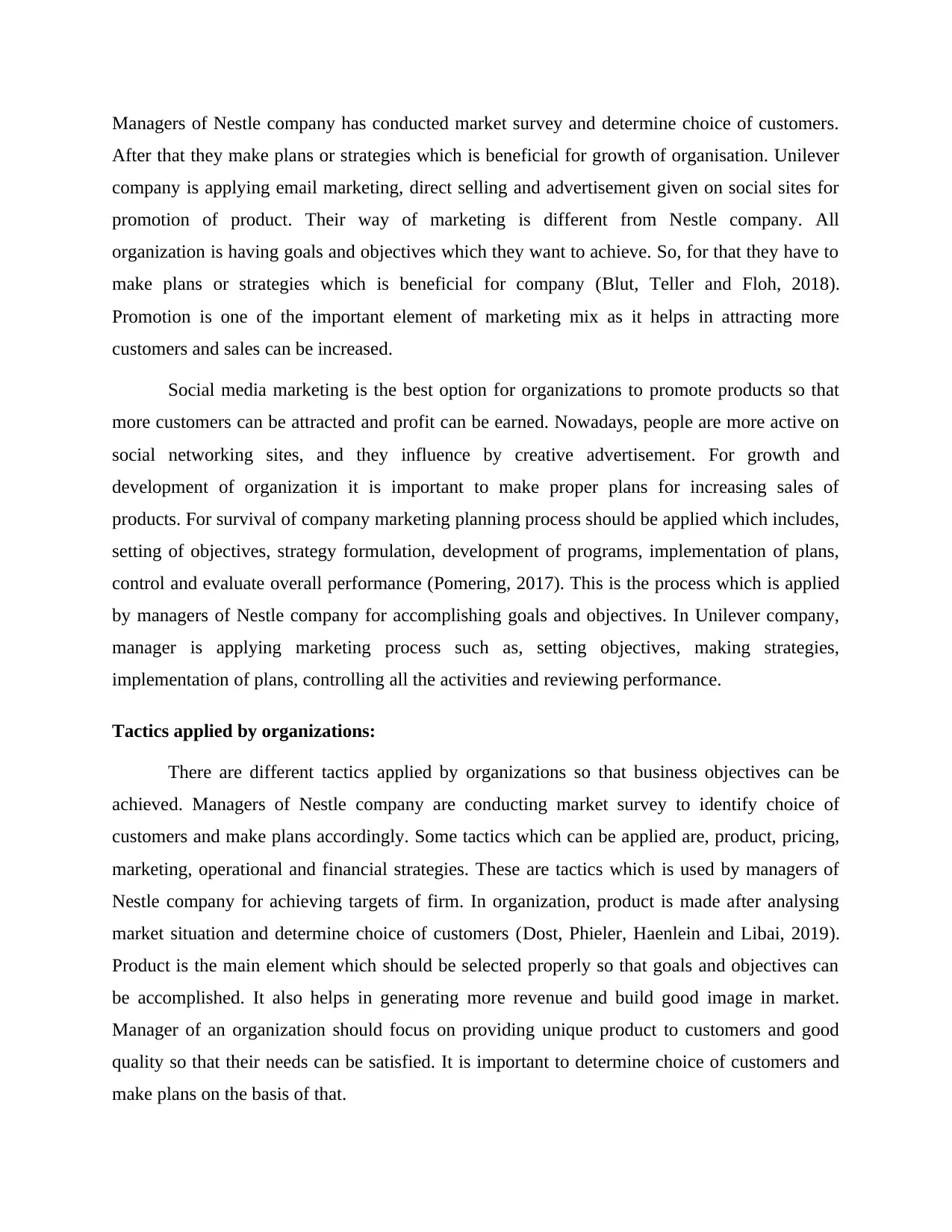
Managers of Nestle company has conducted market survey and determine choice of customers.
After that they make plans or strategies which is beneficial for growth of organisation. Unilever
company is applying email marketing, direct selling and advertisement given on social sites for
promotion of product. Their way of marketing is different from Nestle company. All
organization is having goals and objectives which they want to achieve. So, for that they have to
make plans or strategies which is beneficial for company (Blut, Teller and Floh, 2018).
Promotion is one of the important element of marketing mix as it helps in attracting more
customers and sales can be increased.
Social media marketing is the best option for organizations to promote products so that
more customers can be attracted and profit can be earned. Nowadays, people are more active on
social networking sites, and they influence by creative advertisement. For growth and
development of organization it is important to make proper plans for increasing sales of
products. For survival of company marketing planning process should be applied which includes,
setting of objectives, strategy formulation, development of programs, implementation of plans,
control and evaluate overall performance (Pomering, 2017). This is the process which is applied
by managers of Nestle company for accomplishing goals and objectives. In Unilever company,
manager is applying marketing process such as, setting objectives, making strategies,
implementation of plans, controlling all the activities and reviewing performance.
Tactics applied by organizations:
There are different tactics applied by organizations so that business objectives can be
achieved. Managers of Nestle company are conducting market survey to identify choice of
customers and make plans accordingly. Some tactics which can be applied are, product, pricing,
marketing, operational and financial strategies. These are tactics which is used by managers of
Nestle company for achieving targets of firm. In organization, product is made after analysing
market situation and determine choice of customers (Dost, Phieler, Haenlein and Libai, 2019).
Product is the main element which should be selected properly so that goals and objectives can
be accomplished. It also helps in generating more revenue and build good image in market.
Manager of an organization should focus on providing unique product to customers and good
quality so that their needs can be satisfied. It is important to determine choice of customers and
make plans on the basis of that.
After that they make plans or strategies which is beneficial for growth of organisation. Unilever
company is applying email marketing, direct selling and advertisement given on social sites for
promotion of product. Their way of marketing is different from Nestle company. All
organization is having goals and objectives which they want to achieve. So, for that they have to
make plans or strategies which is beneficial for company (Blut, Teller and Floh, 2018).
Promotion is one of the important element of marketing mix as it helps in attracting more
customers and sales can be increased.
Social media marketing is the best option for organizations to promote products so that
more customers can be attracted and profit can be earned. Nowadays, people are more active on
social networking sites, and they influence by creative advertisement. For growth and
development of organization it is important to make proper plans for increasing sales of
products. For survival of company marketing planning process should be applied which includes,
setting of objectives, strategy formulation, development of programs, implementation of plans,
control and evaluate overall performance (Pomering, 2017). This is the process which is applied
by managers of Nestle company for accomplishing goals and objectives. In Unilever company,
manager is applying marketing process such as, setting objectives, making strategies,
implementation of plans, controlling all the activities and reviewing performance.
Tactics applied by organizations:
There are different tactics applied by organizations so that business objectives can be
achieved. Managers of Nestle company are conducting market survey to identify choice of
customers and make plans accordingly. Some tactics which can be applied are, product, pricing,
marketing, operational and financial strategies. These are tactics which is used by managers of
Nestle company for achieving targets of firm. In organization, product is made after analysing
market situation and determine choice of customers (Dost, Phieler, Haenlein and Libai, 2019).
Product is the main element which should be selected properly so that goals and objectives can
be accomplished. It also helps in generating more revenue and build good image in market.
Manager of an organization should focus on providing unique product to customers and good
quality so that their needs can be satisfied. It is important to determine choice of customers and
make plans on the basis of that.
Secure Best Marks with AI Grader
Need help grading? Try our AI Grader for instant feedback on your assignments.
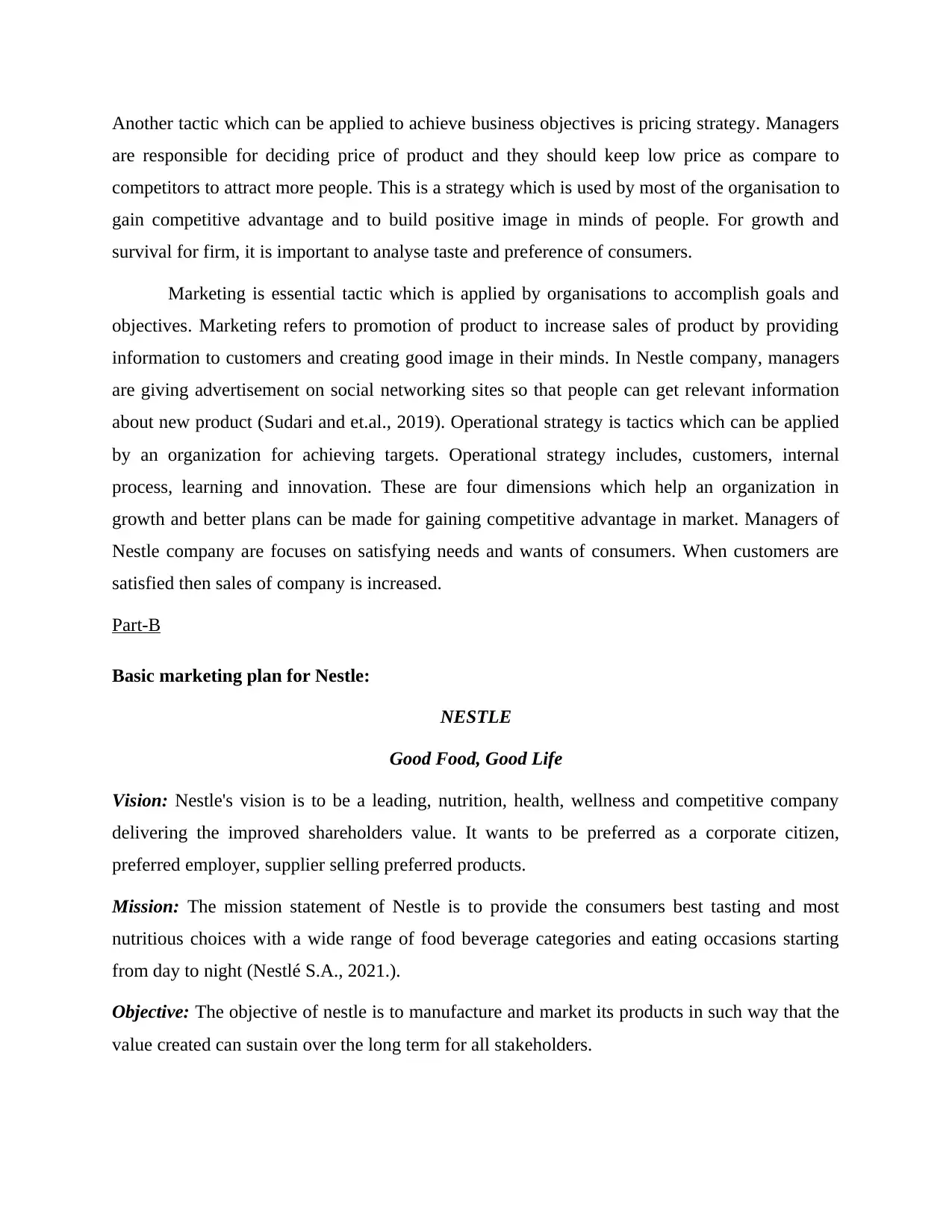
Another tactic which can be applied to achieve business objectives is pricing strategy. Managers
are responsible for deciding price of product and they should keep low price as compare to
competitors to attract more people. This is a strategy which is used by most of the organisation to
gain competitive advantage and to build positive image in minds of people. For growth and
survival for firm, it is important to analyse taste and preference of consumers.
Marketing is essential tactic which is applied by organisations to accomplish goals and
objectives. Marketing refers to promotion of product to increase sales of product by providing
information to customers and creating good image in their minds. In Nestle company, managers
are giving advertisement on social networking sites so that people can get relevant information
about new product (Sudari and et.al., 2019). Operational strategy is tactics which can be applied
by an organization for achieving targets. Operational strategy includes, customers, internal
process, learning and innovation. These are four dimensions which help an organization in
growth and better plans can be made for gaining competitive advantage in market. Managers of
Nestle company are focuses on satisfying needs and wants of consumers. When customers are
satisfied then sales of company is increased.
Part-B
Basic marketing plan for Nestle:
NESTLE
Good Food, Good Life
Vision: Nestle's vision is to be a leading, nutrition, health, wellness and competitive company
delivering the improved shareholders value. It wants to be preferred as a corporate citizen,
preferred employer, supplier selling preferred products.
Mission: The mission statement of Nestle is to provide the consumers best tasting and most
nutritious choices with a wide range of food beverage categories and eating occasions starting
from day to night (Nestlé S.A., 2021.).
Objective: The objective of nestle is to manufacture and market its products in such way that the
value created can sustain over the long term for all stakeholders.
are responsible for deciding price of product and they should keep low price as compare to
competitors to attract more people. This is a strategy which is used by most of the organisation to
gain competitive advantage and to build positive image in minds of people. For growth and
survival for firm, it is important to analyse taste and preference of consumers.
Marketing is essential tactic which is applied by organisations to accomplish goals and
objectives. Marketing refers to promotion of product to increase sales of product by providing
information to customers and creating good image in their minds. In Nestle company, managers
are giving advertisement on social networking sites so that people can get relevant information
about new product (Sudari and et.al., 2019). Operational strategy is tactics which can be applied
by an organization for achieving targets. Operational strategy includes, customers, internal
process, learning and innovation. These are four dimensions which help an organization in
growth and better plans can be made for gaining competitive advantage in market. Managers of
Nestle company are focuses on satisfying needs and wants of consumers. When customers are
satisfied then sales of company is increased.
Part-B
Basic marketing plan for Nestle:
NESTLE
Good Food, Good Life
Vision: Nestle's vision is to be a leading, nutrition, health, wellness and competitive company
delivering the improved shareholders value. It wants to be preferred as a corporate citizen,
preferred employer, supplier selling preferred products.
Mission: The mission statement of Nestle is to provide the consumers best tasting and most
nutritious choices with a wide range of food beverage categories and eating occasions starting
from day to night (Nestlé S.A., 2021.).
Objective: The objective of nestle is to manufacture and market its products in such way that the
value created can sustain over the long term for all stakeholders.
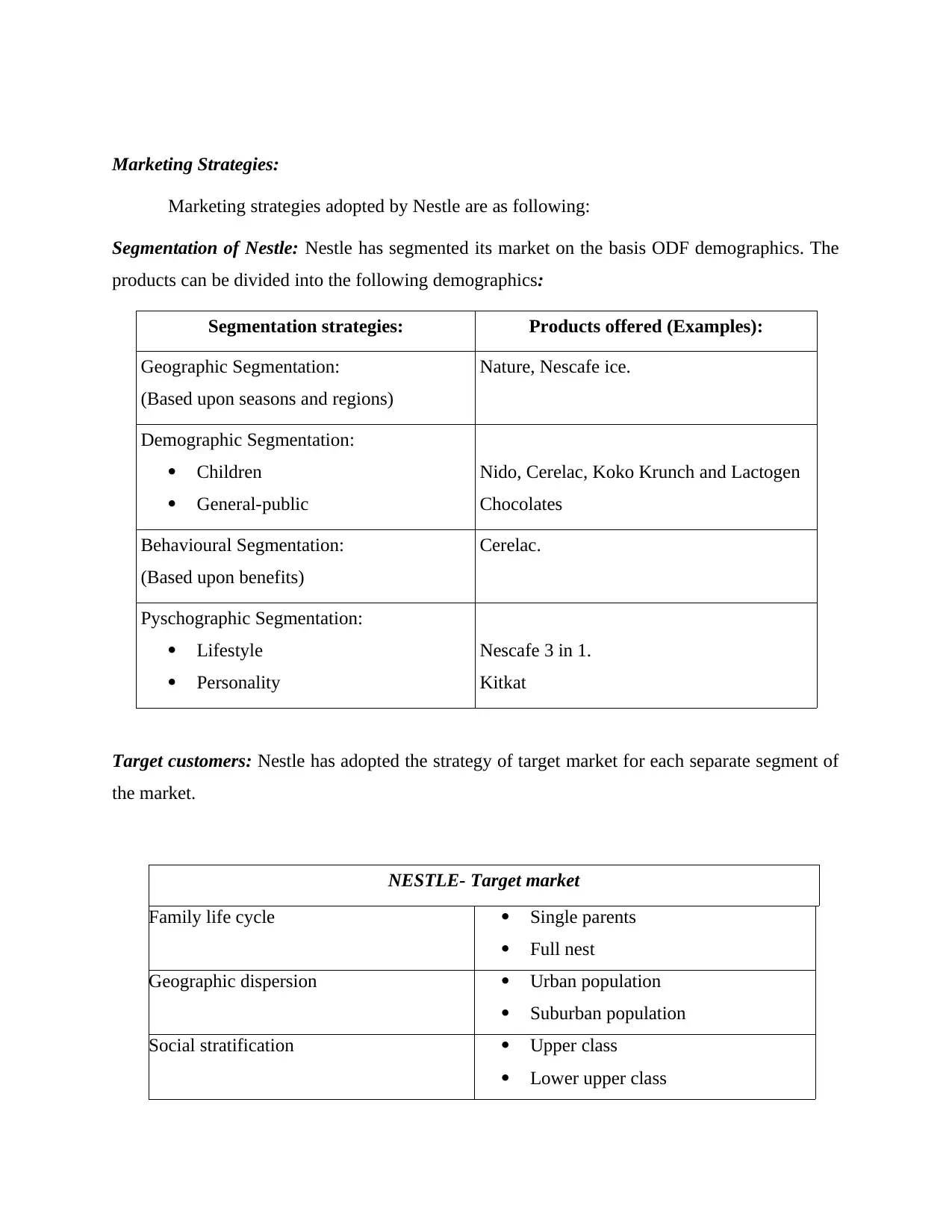
Marketing Strategies:
Marketing strategies adopted by Nestle are as following:
Segmentation of Nestle: Nestle has segmented its market on the basis ODF demographics. The
products can be divided into the following demographics:
Segmentation strategies: Products offered (Examples):
Geographic Segmentation:
(Based upon seasons and regions)
Nature, Nescafe ice.
Demographic Segmentation:
Children
General-public
Nido, Cerelac, Koko Krunch and Lactogen
Chocolates
Behavioural Segmentation:
(Based upon benefits)
Cerelac.
Pyschographic Segmentation:
Lifestyle
Personality
Nescafe 3 in 1.
Kitkat
Target customers: Nestle has adopted the strategy of target market for each separate segment of
the market.
NESTLE- Target market
Family life cycle Single parents
Full nest
Geographic dispersion Urban population
Suburban population
Social stratification Upper class
Lower upper class
Marketing strategies adopted by Nestle are as following:
Segmentation of Nestle: Nestle has segmented its market on the basis ODF demographics. The
products can be divided into the following demographics:
Segmentation strategies: Products offered (Examples):
Geographic Segmentation:
(Based upon seasons and regions)
Nature, Nescafe ice.
Demographic Segmentation:
Children
General-public
Nido, Cerelac, Koko Krunch and Lactogen
Chocolates
Behavioural Segmentation:
(Based upon benefits)
Cerelac.
Pyschographic Segmentation:
Lifestyle
Personality
Nescafe 3 in 1.
Kitkat
Target customers: Nestle has adopted the strategy of target market for each separate segment of
the market.
NESTLE- Target market
Family life cycle Single parents
Full nest
Geographic dispersion Urban population
Suburban population
Social stratification Upper class
Lower upper class
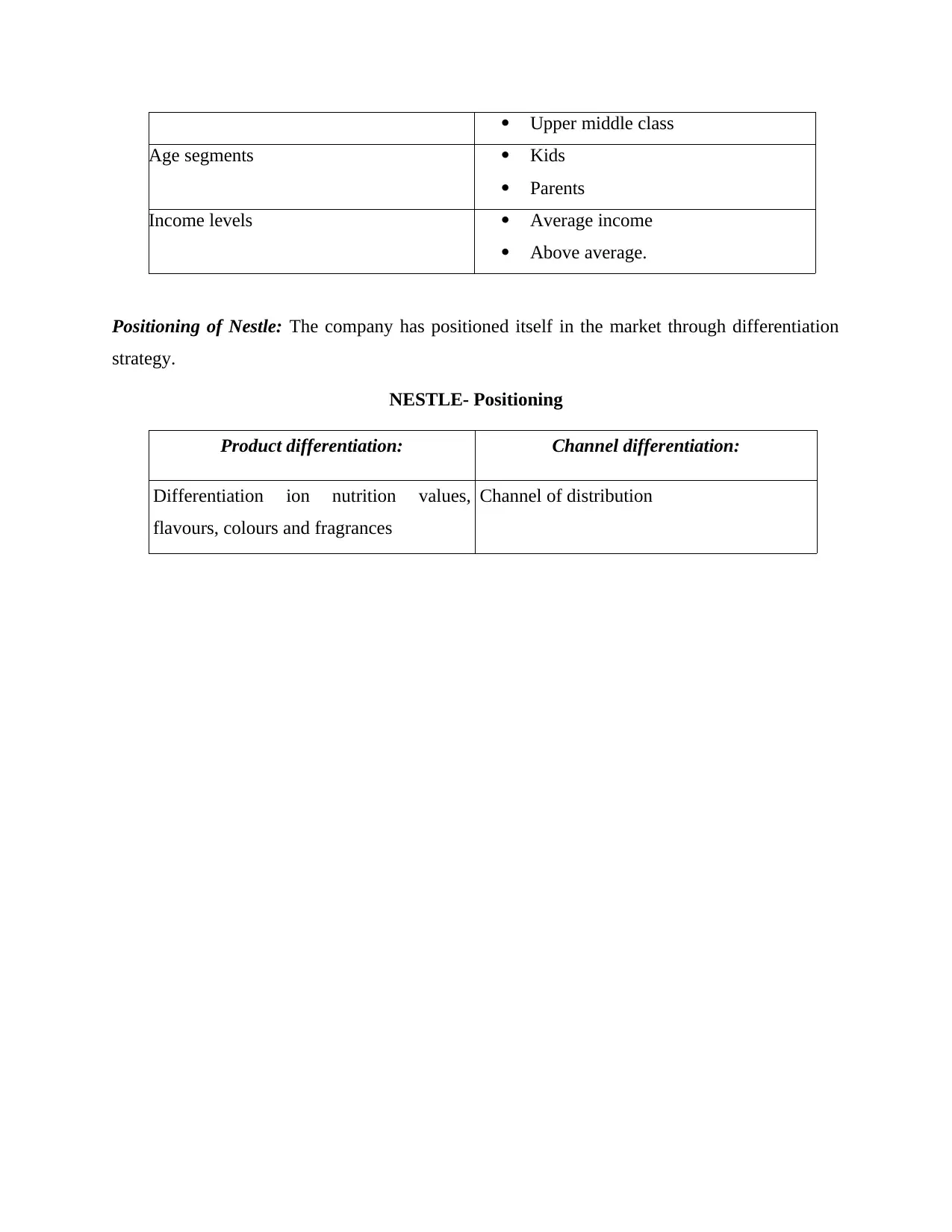
Upper middle class
Age segments Kids
Parents
Income levels Average income
Above average.
Positioning of Nestle: The company has positioned itself in the market through differentiation
strategy.
NESTLE- Positioning
Product differentiation: Channel differentiation:
Differentiation ion nutrition values,
flavours, colours and fragrances
Channel of distribution
Age segments Kids
Parents
Income levels Average income
Above average.
Positioning of Nestle: The company has positioned itself in the market through differentiation
strategy.
NESTLE- Positioning
Product differentiation: Channel differentiation:
Differentiation ion nutrition values,
flavours, colours and fragrances
Channel of distribution
Paraphrase This Document
Need a fresh take? Get an instant paraphrase of this document with our AI Paraphraser

Marketing mix: Marketing mix of Nestle can be explained through the 4P's of marketing such as
following
Product: Nestle offers over 8000 brands of products in high quality and are available in
different sizes, shapes and colours. It mainly deals in Dairy products, chocolates, ready to
cook food and beverages.
Illustration 1: Some products offered by Nestle.
Source: Understanding Nestlé, 2021
following
Product: Nestle offers over 8000 brands of products in high quality and are available in
different sizes, shapes and colours. It mainly deals in Dairy products, chocolates, ready to
cook food and beverages.
Illustration 1: Some products offered by Nestle.
Source: Understanding Nestlé, 2021
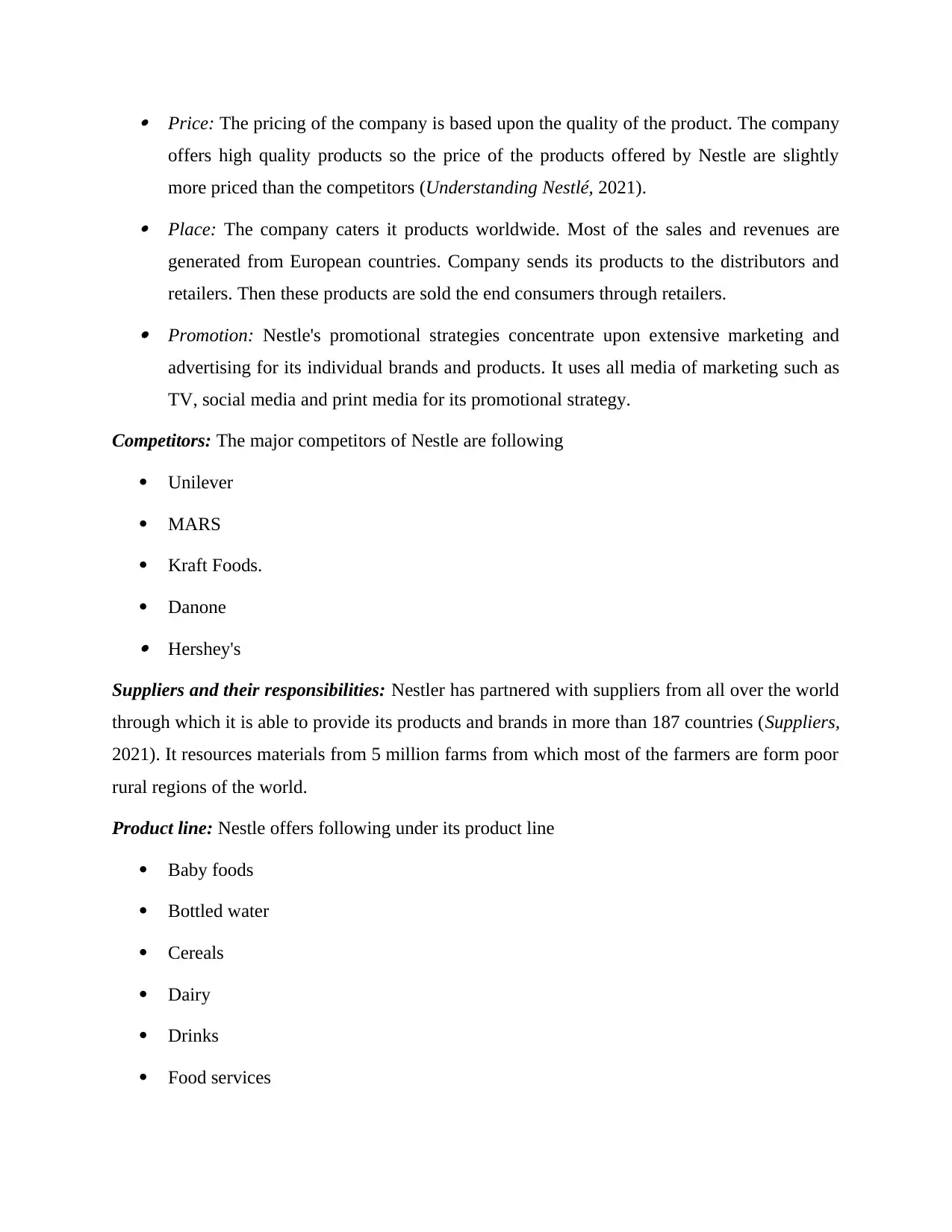
Price: The pricing of the company is based upon the quality of the product. The company
offers high quality products so the price of the products offered by Nestle are slightly
more priced than the competitors (Understanding Nestlé, 2021). Place: The company caters it products worldwide. Most of the sales and revenues are
generated from European countries. Company sends its products to the distributors and
retailers. Then these products are sold the end consumers through retailers. Promotion: Nestle's promotional strategies concentrate upon extensive marketing and
advertising for its individual brands and products. It uses all media of marketing such as
TV, social media and print media for its promotional strategy.
Competitors: The major competitors of Nestle are following
Unilever
MARS
Kraft Foods.
Danone Hershey's
Suppliers and their responsibilities: Nestler has partnered with suppliers from all over the world
through which it is able to provide its products and brands in more than 187 countries (Suppliers,
2021). It resources materials from 5 million farms from which most of the farmers are form poor
rural regions of the world.
Product line: Nestle offers following under its product line
Baby foods
Bottled water
Cereals
Dairy
Drinks
Food services
offers high quality products so the price of the products offered by Nestle are slightly
more priced than the competitors (Understanding Nestlé, 2021). Place: The company caters it products worldwide. Most of the sales and revenues are
generated from European countries. Company sends its products to the distributors and
retailers. Then these products are sold the end consumers through retailers. Promotion: Nestle's promotional strategies concentrate upon extensive marketing and
advertising for its individual brands and products. It uses all media of marketing such as
TV, social media and print media for its promotional strategy.
Competitors: The major competitors of Nestle are following
Unilever
MARS
Kraft Foods.
Danone Hershey's
Suppliers and their responsibilities: Nestler has partnered with suppliers from all over the world
through which it is able to provide its products and brands in more than 187 countries (Suppliers,
2021). It resources materials from 5 million farms from which most of the farmers are form poor
rural regions of the world.
Product line: Nestle offers following under its product line
Baby foods
Bottled water
Cereals
Dairy
Drinks
Food services
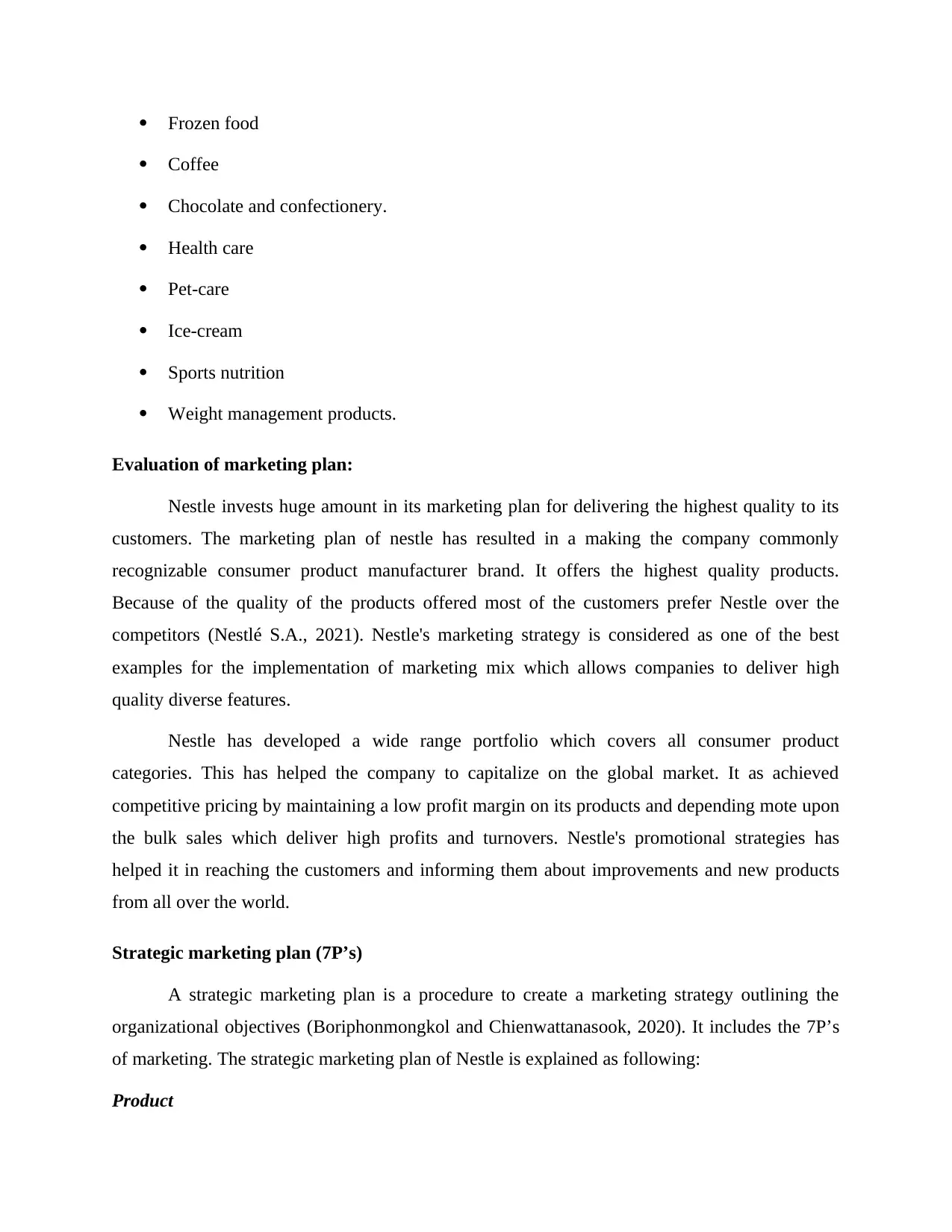
Frozen food
Coffee
Chocolate and confectionery.
Health care
Pet-care
Ice-cream
Sports nutrition
Weight management products.
Evaluation of marketing plan:
Nestle invests huge amount in its marketing plan for delivering the highest quality to its
customers. The marketing plan of nestle has resulted in a making the company commonly
recognizable consumer product manufacturer brand. It offers the highest quality products.
Because of the quality of the products offered most of the customers prefer Nestle over the
competitors (Nestlé S.A., 2021). Nestle's marketing strategy is considered as one of the best
examples for the implementation of marketing mix which allows companies to deliver high
quality diverse features.
Nestle has developed a wide range portfolio which covers all consumer product
categories. This has helped the company to capitalize on the global market. It as achieved
competitive pricing by maintaining a low profit margin on its products and depending mote upon
the bulk sales which deliver high profits and turnovers. Nestle's promotional strategies has
helped it in reaching the customers and informing them about improvements and new products
from all over the world.
Strategic marketing plan (7P’s)
A strategic marketing plan is a procedure to create a marketing strategy outlining the
organizational objectives (Boriphonmongkol and Chienwattanasook, 2020). It includes the 7P’s
of marketing. The strategic marketing plan of Nestle is explained as following:
Product
Coffee
Chocolate and confectionery.
Health care
Pet-care
Ice-cream
Sports nutrition
Weight management products.
Evaluation of marketing plan:
Nestle invests huge amount in its marketing plan for delivering the highest quality to its
customers. The marketing plan of nestle has resulted in a making the company commonly
recognizable consumer product manufacturer brand. It offers the highest quality products.
Because of the quality of the products offered most of the customers prefer Nestle over the
competitors (Nestlé S.A., 2021). Nestle's marketing strategy is considered as one of the best
examples for the implementation of marketing mix which allows companies to deliver high
quality diverse features.
Nestle has developed a wide range portfolio which covers all consumer product
categories. This has helped the company to capitalize on the global market. It as achieved
competitive pricing by maintaining a low profit margin on its products and depending mote upon
the bulk sales which deliver high profits and turnovers. Nestle's promotional strategies has
helped it in reaching the customers and informing them about improvements and new products
from all over the world.
Strategic marketing plan (7P’s)
A strategic marketing plan is a procedure to create a marketing strategy outlining the
organizational objectives (Boriphonmongkol and Chienwattanasook, 2020). It includes the 7P’s
of marketing. The strategic marketing plan of Nestle is explained as following:
Product
Secure Best Marks with AI Grader
Need help grading? Try our AI Grader for instant feedback on your assignments.
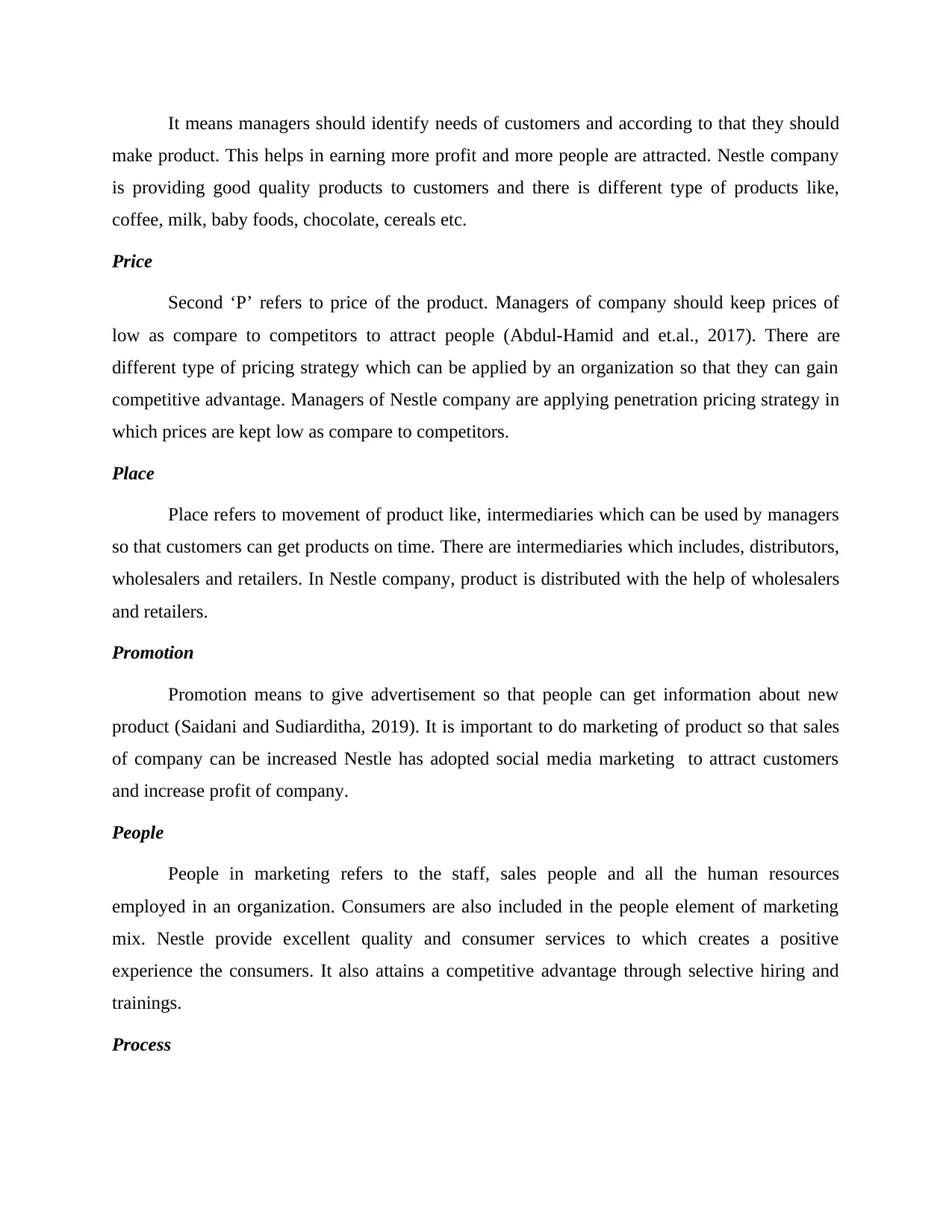
It means managers should identify needs of customers and according to that they should
make product. This helps in earning more profit and more people are attracted. Nestle company
is providing good quality products to customers and there is different type of products like,
coffee, milk, baby foods, chocolate, cereals etc.
Price
Second ‘P’ refers to price of the product. Managers of company should keep prices of
low as compare to competitors to attract people (Abdul-Hamid and et.al., 2017). There are
different type of pricing strategy which can be applied by an organization so that they can gain
competitive advantage. Managers of Nestle company are applying penetration pricing strategy in
which prices are kept low as compare to competitors.
Place
Place refers to movement of product like, intermediaries which can be used by managers
so that customers can get products on time. There are intermediaries which includes, distributors,
wholesalers and retailers. In Nestle company, product is distributed with the help of wholesalers
and retailers.
Promotion
Promotion means to give advertisement so that people can get information about new
product (Saidani and Sudiarditha, 2019). It is important to do marketing of product so that sales
of company can be increased Nestle has adopted social media marketing to attract customers
and increase profit of company.
People
People in marketing refers to the staff, sales people and all the human resources
employed in an organization. Consumers are also included in the people element of marketing
mix. Nestle provide excellent quality and consumer services to which creates a positive
experience the consumers. It also attains a competitive advantage through selective hiring and
trainings.
Process
make product. This helps in earning more profit and more people are attracted. Nestle company
is providing good quality products to customers and there is different type of products like,
coffee, milk, baby foods, chocolate, cereals etc.
Price
Second ‘P’ refers to price of the product. Managers of company should keep prices of
low as compare to competitors to attract people (Abdul-Hamid and et.al., 2017). There are
different type of pricing strategy which can be applied by an organization so that they can gain
competitive advantage. Managers of Nestle company are applying penetration pricing strategy in
which prices are kept low as compare to competitors.
Place
Place refers to movement of product like, intermediaries which can be used by managers
so that customers can get products on time. There are intermediaries which includes, distributors,
wholesalers and retailers. In Nestle company, product is distributed with the help of wholesalers
and retailers.
Promotion
Promotion means to give advertisement so that people can get information about new
product (Saidani and Sudiarditha, 2019). It is important to do marketing of product so that sales
of company can be increased Nestle has adopted social media marketing to attract customers
and increase profit of company.
People
People in marketing refers to the staff, sales people and all the human resources
employed in an organization. Consumers are also included in the people element of marketing
mix. Nestle provide excellent quality and consumer services to which creates a positive
experience the consumers. It also attains a competitive advantage through selective hiring and
trainings.
Process
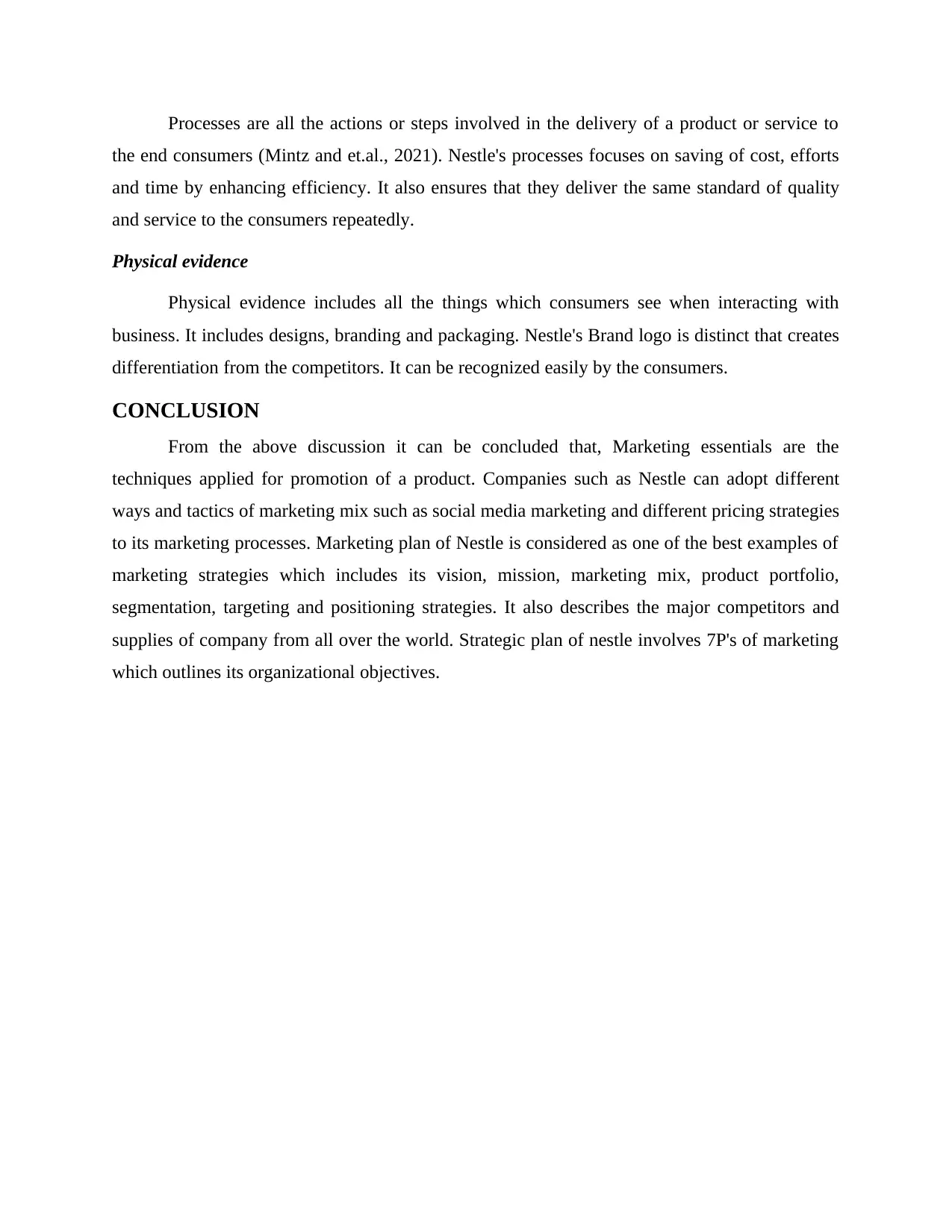
Processes are all the actions or steps involved in the delivery of a product or service to
the end consumers (Mintz and et.al., 2021). Nestle's processes focuses on saving of cost, efforts
and time by enhancing efficiency. It also ensures that they deliver the same standard of quality
and service to the consumers repeatedly.
Physical evidence
Physical evidence includes all the things which consumers see when interacting with
business. It includes designs, branding and packaging. Nestle's Brand logo is distinct that creates
differentiation from the competitors. It can be recognized easily by the consumers.
CONCLUSION
From the above discussion it can be concluded that, Marketing essentials are the
techniques applied for promotion of a product. Companies such as Nestle can adopt different
ways and tactics of marketing mix such as social media marketing and different pricing strategies
to its marketing processes. Marketing plan of Nestle is considered as one of the best examples of
marketing strategies which includes its vision, mission, marketing mix, product portfolio,
segmentation, targeting and positioning strategies. It also describes the major competitors and
supplies of company from all over the world. Strategic plan of nestle involves 7P's of marketing
which outlines its organizational objectives.
the end consumers (Mintz and et.al., 2021). Nestle's processes focuses on saving of cost, efforts
and time by enhancing efficiency. It also ensures that they deliver the same standard of quality
and service to the consumers repeatedly.
Physical evidence
Physical evidence includes all the things which consumers see when interacting with
business. It includes designs, branding and packaging. Nestle's Brand logo is distinct that creates
differentiation from the competitors. It can be recognized easily by the consumers.
CONCLUSION
From the above discussion it can be concluded that, Marketing essentials are the
techniques applied for promotion of a product. Companies such as Nestle can adopt different
ways and tactics of marketing mix such as social media marketing and different pricing strategies
to its marketing processes. Marketing plan of Nestle is considered as one of the best examples of
marketing strategies which includes its vision, mission, marketing mix, product portfolio,
segmentation, targeting and positioning strategies. It also describes the major competitors and
supplies of company from all over the world. Strategic plan of nestle involves 7P's of marketing
which outlines its organizational objectives.
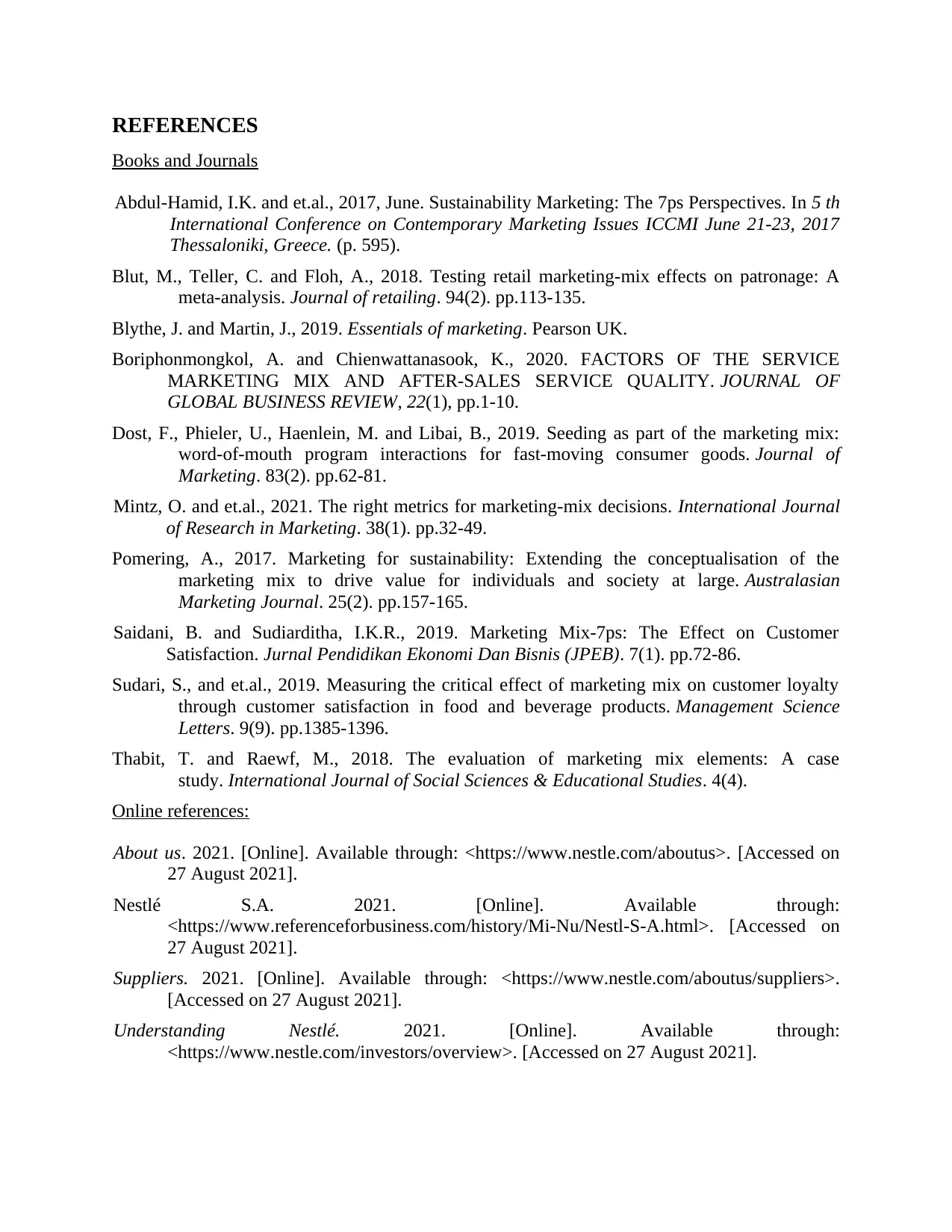
REFERENCES
Books and Journals
Abdul-Hamid, I.K. and et.al., 2017, June. Sustainability Marketing: The 7ps Perspectives. In 5 th
International Conference on Contemporary Marketing Issues ICCMI June 21-23, 2017
Thessaloniki, Greece. (p. 595).
Blut, M., Teller, C. and Floh, A., 2018. Testing retail marketing-mix effects on patronage: A
meta-analysis. Journal of retailing. 94(2). pp.113-135.
Blythe, J. and Martin, J., 2019. Essentials of marketing. Pearson UK.
Boriphonmongkol, A. and Chienwattanasook, K., 2020. FACTORS OF THE SERVICE
MARKETING MIX AND AFTER-SALES SERVICE QUALITY. JOURNAL OF
GLOBAL BUSINESS REVIEW, 22(1), pp.1-10.
Dost, F., Phieler, U., Haenlein, M. and Libai, B., 2019. Seeding as part of the marketing mix:
word-of-mouth program interactions for fast-moving consumer goods. Journal of
Marketing. 83(2). pp.62-81.
Mintz, O. and et.al., 2021. The right metrics for marketing-mix decisions. International Journal
of Research in Marketing. 38(1). pp.32-49.
Pomering, A., 2017. Marketing for sustainability: Extending the conceptualisation of the
marketing mix to drive value for individuals and society at large. Australasian
Marketing Journal. 25(2). pp.157-165.
Saidani, B. and Sudiarditha, I.K.R., 2019. Marketing Mix-7ps: The Effect on Customer
Satisfaction. Jurnal Pendidikan Ekonomi Dan Bisnis (JPEB). 7(1). pp.72-86.
Sudari, S., and et.al., 2019. Measuring the critical effect of marketing mix on customer loyalty
through customer satisfaction in food and beverage products. Management Science
Letters. 9(9). pp.1385-1396.
Thabit, T. and Raewf, M., 2018. The evaluation of marketing mix elements: A case
study. International Journal of Social Sciences & Educational Studies. 4(4).
Online references:
About us. 2021. [Online]. Available through: <https://www.nestle.com/aboutus>. [Accessed on
27 August 2021].
Nestlé S.A. 2021. [Online]. Available through:
<https://www.referenceforbusiness.com/history/Mi-Nu/Nestl-S-A.html>. [Accessed on
27 August 2021].
Suppliers. 2021. [Online]. Available through: <https://www.nestle.com/aboutus/suppliers>.
[Accessed on 27 August 2021].
Understanding Nestlé. 2021. [Online]. Available through:
<https://www.nestle.com/investors/overview>. [Accessed on 27 August 2021].
Books and Journals
Abdul-Hamid, I.K. and et.al., 2017, June. Sustainability Marketing: The 7ps Perspectives. In 5 th
International Conference on Contemporary Marketing Issues ICCMI June 21-23, 2017
Thessaloniki, Greece. (p. 595).
Blut, M., Teller, C. and Floh, A., 2018. Testing retail marketing-mix effects on patronage: A
meta-analysis. Journal of retailing. 94(2). pp.113-135.
Blythe, J. and Martin, J., 2019. Essentials of marketing. Pearson UK.
Boriphonmongkol, A. and Chienwattanasook, K., 2020. FACTORS OF THE SERVICE
MARKETING MIX AND AFTER-SALES SERVICE QUALITY. JOURNAL OF
GLOBAL BUSINESS REVIEW, 22(1), pp.1-10.
Dost, F., Phieler, U., Haenlein, M. and Libai, B., 2019. Seeding as part of the marketing mix:
word-of-mouth program interactions for fast-moving consumer goods. Journal of
Marketing. 83(2). pp.62-81.
Mintz, O. and et.al., 2021. The right metrics for marketing-mix decisions. International Journal
of Research in Marketing. 38(1). pp.32-49.
Pomering, A., 2017. Marketing for sustainability: Extending the conceptualisation of the
marketing mix to drive value for individuals and society at large. Australasian
Marketing Journal. 25(2). pp.157-165.
Saidani, B. and Sudiarditha, I.K.R., 2019. Marketing Mix-7ps: The Effect on Customer
Satisfaction. Jurnal Pendidikan Ekonomi Dan Bisnis (JPEB). 7(1). pp.72-86.
Sudari, S., and et.al., 2019. Measuring the critical effect of marketing mix on customer loyalty
through customer satisfaction in food and beverage products. Management Science
Letters. 9(9). pp.1385-1396.
Thabit, T. and Raewf, M., 2018. The evaluation of marketing mix elements: A case
study. International Journal of Social Sciences & Educational Studies. 4(4).
Online references:
About us. 2021. [Online]. Available through: <https://www.nestle.com/aboutus>. [Accessed on
27 August 2021].
Nestlé S.A. 2021. [Online]. Available through:
<https://www.referenceforbusiness.com/history/Mi-Nu/Nestl-S-A.html>. [Accessed on
27 August 2021].
Suppliers. 2021. [Online]. Available through: <https://www.nestle.com/aboutus/suppliers>.
[Accessed on 27 August 2021].
Understanding Nestlé. 2021. [Online]. Available through:
<https://www.nestle.com/investors/overview>. [Accessed on 27 August 2021].
1 out of 13
Related Documents
Your All-in-One AI-Powered Toolkit for Academic Success.
+13062052269
info@desklib.com
Available 24*7 on WhatsApp / Email
![[object Object]](/_next/static/media/star-bottom.7253800d.svg)
Unlock your academic potential
© 2024 | Zucol Services PVT LTD | All rights reserved.





